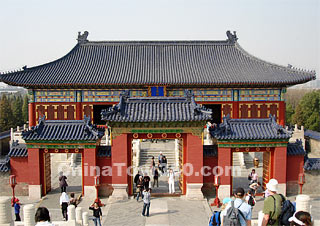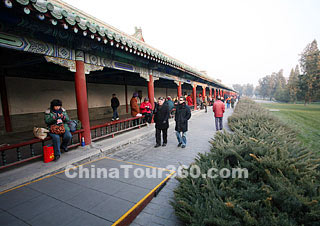The Architectural Complex of the Altar of Prayer for Good Harvest is part of an architectural complex where the Ming and Qing emperors held ceremonies for good weather and bountiful harvest. Located in the northern part of the Temple of Heaven, the altar is a three-tier round building surrounded by rails of white marble and hornless-dragon heads. The upper tier is carved with relief of dragons, and the remaining two tiers are carved with a phoenix and cloud formations.
The wall enclosing the Altar of Prayer for Good Harvests is made of brick and is festooned with green glazed cylindrical tiles. It is 190 meters (207.8 yards) long and 160 meters (175 yards) wide. It stands on a giant brick and stone base of 4.5 meters (14.8 feet) high. The wall has four brick doors - one each on the north, south, east and west sides. The Gate of Prayer for Good Harvests can be seen after passing through the south entrance.
The Gate of Prayer for Good Harvests is one of the rare existing examples of the Ming Dynasty (1368 - 1644) architecture in the Temple of Heaven. Behind the Gate, there is a spacious courtyard, in the center of which is the Altar of Prayer for Good Harvests and the world-famous Hall of Prayer for Good Harvests. The Hall of Prayer for Good Harvests, also known as 'Beamless Hall’, is regarded as one of the five wonders of the Temple of Heaven. It is also the symbol of the ancient cultural capital of Beijing. The hall is a circular building with a diameter of 32.72 meters (107.3 feet) and a height of 38 meters (124.7 feet). It was designed based on the concept of "Respect to the Heaven and God". The round hall symbolizes the shape of the sky, while the blue tiles represent the color o sky.
The Architectural Complex housing the Altar of Prayer for Good Harvest also includes the East and West Annex Halls, the Imperial Hall of Heaven, the Long Corridor, the Divine Kitchen, the Butcher Pavilion and the Danbi Bridge. The East Annex Hall now displays a large number of records and artifacts depicting the Hall of Prayer for Good Harvest’s history.
|
|
The Imperial Hall of Heaven is located in the same rectangular courtyard as the Altar of Prayer for Good Harvests and is connected to it by glazed doors. In the early Qing Dynasty (1644 - 1911), it was the location of the tablet of the God of the Heaven. In accordance with ritual, the emperor would burn incense and make sure the altar and oblations were in order on the day before the sacrificial ceremony. In order to express respect to the God of the Heaven, the sacrificial officials of the Taichang Temple would go burn incense and sweep away dust on the first and fifteenth days of the Spring Festival.
 |
| Danbi Bridge |
The Danbi Bridge is a spacious walkway just outside of the Chengzhen Gate. It’s a major axis connecting the Circular Mound Altar in the south of the Temple of Heaven and the Altar of Prayer for Good Harvests in the north. "Danbi" refers to the steps especially for the emperor. There are two reasons for the name "Bridge". One is that the northern part of the bridge is slightly higher than the southern part, symbolizing the ascent to the heaven. The other is that there is a channel under the bridge serving as a passage for animals. It is east-west in direction and is called Livestock Road. Ritual animals to be slaughtered at the Butcher Pavilion must pass through this channel. Since the animals have no chance of survival once they begin the crossing, the channel is called the "Gate of Hell".
Under the strict legislative system, emperors in ancient China had prescribed routes to get to the sacrifices in the Temple of Heaven. While the route was not long for a young emperor, it could prove arduous for the elders. Therefore, Emperor Qianlong ordered two doors built when he worshipped. The first door was built when he became 62 years old and the second when he turned 71. The first door was named 'Huajia' (meaning over sixty hears old) and the second one was called 'Guxi' (meaning over seventy years old). In order to prevent future generations from being lazy, the emperor stipulated that only emperors over the age of sixty could use the Huajia Door and only those over seventy could use the Guxi Door. As it turned out, only Emperor Qianlong ever used the Guxi Door and only Emperor Jiaqing used the Huajia Door.
![]() Go to the Next Attraction: Architectural Complex of Palace of Abstinence
Go to the Next Attraction: Architectural Complex of Palace of Abstinence










